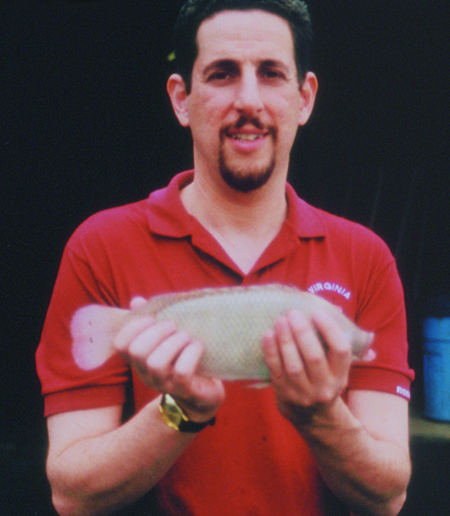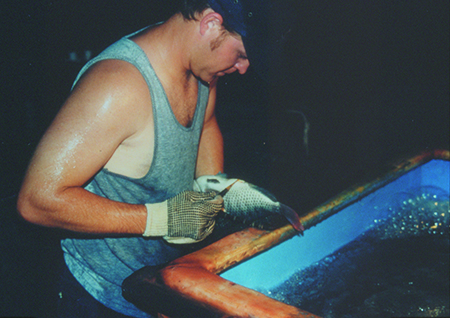Blue Ridge Aquaculture achieves successful, in-house selective breeding

A growing sector of the aquaculture industry produces fish in recirculating aquaculture systems (RAS). To date, development of RAS has tended to emphasize the production systems, as opposed to the cultured stocks. As the sector matures, however, it becomes appropriate to broaden the focus to consider the genetics of cultured stocks.
The profitability of RAS will depend, in part, on development of genetic lines suitable for growth under the conditions of high density and suboptimal water quality found in RAS. Key species currently produced in RAS include tilapia (Oreochromis sp.), striped and hybrid bass (Morone sp.) and ornamentals. Culture of yellow perch (Perca flavescens) and Arctic charr (Salvelinus alpinus) is also emerging as commercially viable.
Tilapia and RAS
Tilapia are highly suited for production in RAS. They show high tolerance to crowding, ready acceptance of a wide range of foods, good feed-conversion efficiency, rapid growth rate, and ease of reproduction. They also are suitable for selective breeding to improve key traits.
An ongoing case study of selective breeding of hybrid tilapia at Blue Ridge Aquaculture of Martinsville in Virginia, USA shows how selective breeding can be practiced in the context of commercial production in RAS. The facility produces over 900 metric tons (MT) of tilapia annually. Breeding goals, light body coloration, and rapid growth rates are approached using classical selective breeding.
Selective breeding methods
Study staff started with a typical gray tilapia strain with genetic background including the well-known Rocky Mountain white strain. Reproducing broodstock are held in two lined earthen ponds in a greenhouse. Every seven days, workers collect eggs or fry from the females’ mouths.
This makes the females spawn sooner, but – more importantly from the geneticist’s viewpoint – also allows the rearing of groups of equal-aged young fish. Some of these groups ultimately will be subject to selection for purposes of broodstock replacement.
Hatching and rearing
The eggs are hatched in McDonald hatching jars. Fry are transferred to 4.5-cubic-meter tanks for rearing to 1 gram. These fish are then transferred to lined earthen ponds in another greenhouse for growth to 30 grams. At this size, fish are transferred into RAS with 214-cubic-meter tanks for grow-out to 500 grams.
Fish are graded at least three times through the grow-out period. Those found more than 10 percent smaller than the norm are discarded through the production process.
Broodstock selection

When they reach market size, broodstock candidates are sorted by sex. Five hundred males and 1,400 females are needed as broodstock for the next generation. Based on the number of broodstock candidates on hand, selection intensity can be determined.
A sample is taken to determine the minimum weight criterion for selection for each sex. Then, only the light-colored, rapidly growing individuals are selected as broodstock. For example, in the second generation, 40 percent of the grown-out males and 60 percent of the females were selected. Since selection comes after at least three gradings, selection intensities are actually much higher: roughly 13 percent for males and 37 percent for females. The program is now in its fourth generation of selection.
Two genetic lines
Throughout the entire process of rearing broodstock replacements, prospective broodstock are maintained as two genetic lines: A and B. At spawning time, males from one line are mated only with females of the other. This practice minimizes the rate of inbreeding accumulation.
Response to selection
Typical coloration of the tilapia at the beginning of the selective breeding program included gray saddle marks over the back, and gray coloration along the back. Clear progress has been made on body coloration. A typical fish from the third generation is silvery white and well accepted at market.
Growth
Since the commercial grower was not interested in producing fish from a control line that did not undergo selection, no comparative means of quantifying improvement was established. However, comparative data shows that the growth of the Blue Ridge line (2.3 grams per day) compares favorably with that of other widely cultured tilapia lines.
Other traits
Certain other traits improved in response to selection because they are positively correlated with growth rate in this line. The select line exhibits a good feed-conversion ratio of 1.53, which continues to improve. Though mortality initially was higher than in a reference line, survival has improved with each generation. However, the average size of eggs has decreased.
Conclusion
A study of hybrid tilapia breeding at Blue Ridge Aquaculture of Martinsville represents the minimum scale needed for achieving successful, in-house selective breeding. It incorporates a commitment to grow equal-aged groups of fish and to maintain and evaluate broodstock replacement candidates. In practical terms, it represents a commitment of tank space and human effort that must be regarded as an investment. Though it was regarded as a risk at the outset, Blue Ridge Aquaculture maintains the selective breeding program because it is justified as a business decision.
(Editor’s Note: This article was originally published in the June 2002 print edition of the Global Aquaculture Advocate.)
Now that you've finished reading the article ...
… we hope you’ll consider supporting our mission to document the evolution of the global aquaculture industry and share our vast network of contributors’ expansive knowledge every week.
By becoming a Global Seafood Alliance member, you’re ensuring that all of the pre-competitive work we do through member benefits, resources and events can continue. Individual membership costs just $50 a year. GSA individual and corporate members receive complimentary access to a series of GOAL virtual events beginning in April. Join now.
Not a GSA member? Join us.
Author
-
Eric M. Hallerman, Ph.D.
Department of Fisheries and Wildlife Sciences
Virginia Polytechnic Institute and State University
Blacksburg, Virginia 24061 USA
Related Posts

Health & Welfare
A holistic management approach to EMS
Early Mortality Syndrome has devastated farmed shrimp in Asia and Latin America. With better understanding of the pathogen and the development and improvement of novel strategies, shrimp farmers are now able to better manage the disease.

Health & Welfare
A look at tilapia aquaculture in Ghana
Aquaculture in Ghana has overcome its historic fits and starts and is helping to narrow the gap between domestic seafood production and consumption. Production is based on Nile tilapia.

Health & Welfare
Potential of YY male tilapia technology
YY male tilapia technology, based on the genetic manipulation of sex, provides a robust, reliable method of achieving male fish. It avoids the use of hormones and maintains strain purity in genetically normal males.

Health & Welfare
Atlantic cod genomics and broodstock development project
The Atlantic Cod Genomics and Broodstock Development Project has expanded the gene-related resources for the species in Canada.


